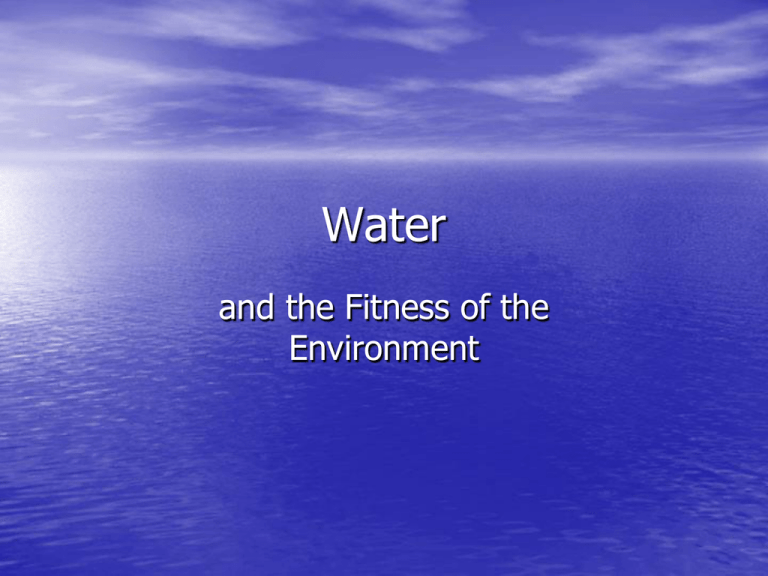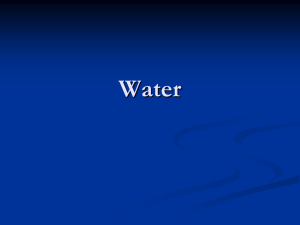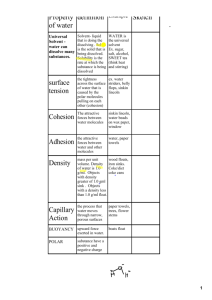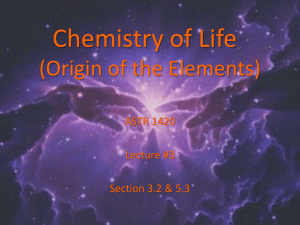Chapter 3
advertisement

Water and the Fitness of the Environment Polarity of Water • Water is a polar • • molecule Hydrogen of one H2O is attracted to the Oxygen of another H2O Therefore, hydrogen bonding occurs Properties of Water • Water has 4 properties that make Earth a fitting environment for life: – High surface tension/Cohesive behavior – Ability to stabilize temperature – Expansion upon freezing – Versatility as a solvent for life 1. Cohesion • Cohesion: – Hydrogen bonds hold water together in liquid form – Responsible for transport of water against gravity in plants Cohesion • Adhesion = clinging of one substance to another – Cohesion = adhesion of water to itself • Surface Tension = how hard it is to stretch or break the surface of a liquid 2. Ability to Stabilize Temperatures • Water… – Absorbs heat from air that is warmer than itself – Releases stored heat to air that is cooler than itself Ability to Stabilize Temperatures • Water’s high specific heat – Specific heat • amount of heat that must be absorbed or lost for 1g of that substance to raise its temperature by 1C – Because of its high specific heat (due to hydrogen bonding) water resists temperature change • LOTS of hydrogen bonds have to be broken before water molecules can start moving faster Ability to Stabilize Temperatures • Application: – Large body of water can absorb LOTS of heat from the sun – Then, the gradually cooling water warms the air at night and in the winter • Mild climate of coastal areas – Ocean, lake, pond temperatures remain stable – IMPORTANT! 3. Expansion Upon Freezing • Water is less dense as a solid than as a liquid: – Because of hydrogen bonding! • Therefore, ice floats • Ice: – Each water molecule bonded to max of 4 “partners” • Water: – Bonds are constantly breaking and reforming Expansion Upon Freezing • Application and Importance: – Allows marine life to continue to live even when the top layer of water is frozen – Ice acts as an insulator 4. Solvent of Life • Solution: – A liquid that is a homogeneous mixture of 2 or more substances • Solvent: – The dissolving agent – Ie. water • Solute: – Substance that is dissolved – Ie. Kool-aid powder Solvent of Life • Aqueous Solution: – A solution in which water is the solvent • Water is NOT a universal solvent – Why not? Solvent of Life • Hydrophilic: – “water-loving” – Polar and ionic compounds • Hydrophobic: – “water-fearing” – Nonpolar compounds The pH Scale • The dissociation of water H2O H+ + OH- • In water: [H+] = [OH-] The pH Scale • Acid: – A substance that increases the H+ concentration of a solution [H+] > [OH-] • Base: – A substance that decreases the H+ concentration of a solution [H+] < [OH-] The pH Scale • Logarithmic scale of 0 • • – 14 Neutral pH = 7 Acidic pH = <7 – More H+ ions • Basic pH = > 7 – Fewer H+ ions • pH declines as H+ concentration increases Acid Precipitation • pH of normal rain = 5.6 • pH of acid rain = as low as 1.5 (Sulfur oxides or nitrogen oxides) + water acids • Human blood pH = 7.4 – 7.0 or 7.8 = death! • Importance: – Aquatic animals, plants, etc…







